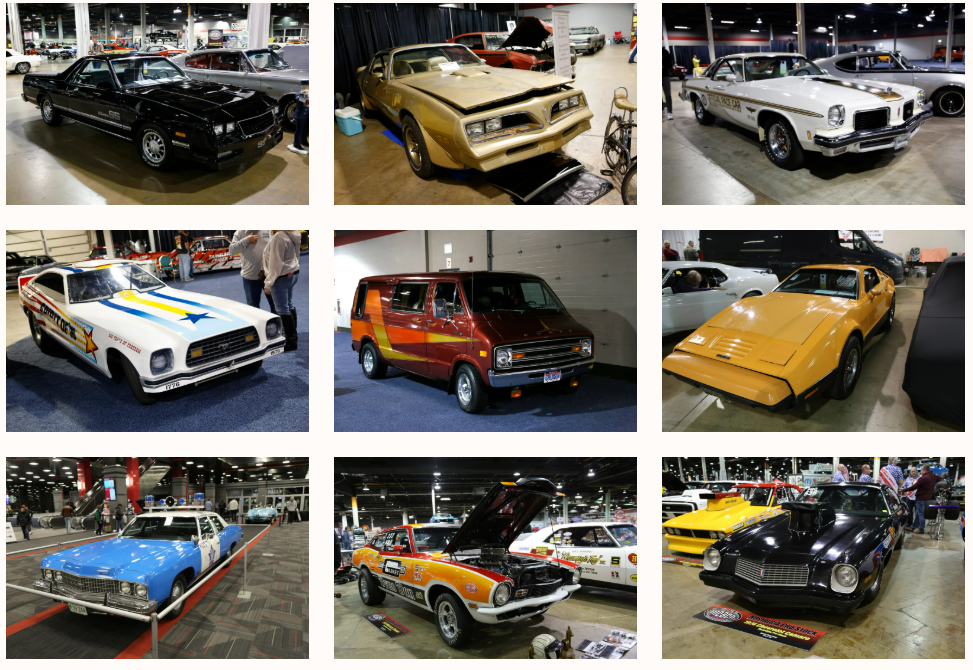The Muscle Car and Corvette Nationals (MCACN) has long been a haven for car enthusiasts, showcasing some of the most iconic muscle cars and Corvettes ever produced. Traditionally, the focus has been on vehicles from 1964 to 1972, a golden era of high-performance American cars. However, the line drawn at 1972 has a significant reason—this was the year when multiple factors began reshaping the automotive industry.
With rising insurance costs, government-mandated safety features such as 5-mph bumpers, and stringent emissions regulations, many believed the muscle car era had ended. While a few exceptions like the 1973-’74 Pontiac Super Duty 455 exist, many potent machines from the following years were often overlooked. However, the MCACN 2024 show proves that muscle cars continued to evolve and thrive even in the so-called “Malaise Era.” This event provided a stunning display of 1970s pony cars, 1980s performance prototypes, and turbocharged marvels that defied the odds.

Muscle Cars After 1972: A Resilient Industry
Despite the setbacks, American automakers did not abandon performance-oriented vehicles. Instead, they adapted to new challenges. MCACN 2024 highlighted many vehicles from the 1970s and 1980s that continued the spirit of muscle cars.
From Dodge Challengers and Chevrolet Camaros to Ford Mustangs and Pontiac Firebirds, manufacturers found ways to maintain excitement, albeit with lower horsepower ratings and additional emissions equipment. This era also saw the introduction of innovative technologies like electronic fuel injection and computer-controlled ignition systems, which helped keep muscle cars relevant.

Celebrating 60 Years of Pontiac GTO
The 2024 event marked the 60th anniversary of the legendary Pontiac GTO, often credited with igniting the muscle car craze. To commemorate this milestone, MCACN featured an extraordinary lineup of GTO models, ranging from the early 1964 Royal Bobcat-tuned “ringer” to the last iterations of the GTO lineage.
Visitors witnessed the evolution of the GTO, including the 1973 Colonnade-bodied version with a 400-cubic-inch engine paired with a four-speed manual transmission. Also present was the 1974 X-body GTO with a 350 engine and a four-speed gearbox. To complete the timeline, the event showcased the modern-era GTO, which was based on the Australian Holden Monaro.

The Rare 1985 Plymouth Barracuda Prototype
One of the most intriguing displays at MCACN 2024 was a rare prototype—the 1985 Plymouth Turismo-based Barracuda. Officially, the Plymouth Barracuda nameplate ceased to exist after the discontinuation of the E-body platform in 1974. However, Chrysler engineers briefly experimented with reviving the model in the mid-1980s.
Using the compact L-body platform, engineers created a turbocharged 2.2-liter pocket rocket. This performance-oriented vehicle was a fascinating glimpse into what could have been a rebirth of the Barracuda. However, the project was scrapped after Carroll Shelby, a key figure in Chrysler’s performance division, opposed it. The red prototype was reportedly destroyed, while the surviving white example continues to make appearances at exclusive car events.

The Rise of Turbocharged Muscle Cars
As large-displacement, high-compression V-8 engines became impractical due to regulations, automakers sought alternative methods to maintain performance. Turbocharging emerged as a viable solution, allowing manufacturers to squeeze more power out of smaller engines.
General Motors experimented with turbocharged versions of the 301-cubic-inch V-8, particularly for the Pontiac Trans Am, to keep the brand’s performance legacy alive. Meanwhile, Don Yenko’s Turbo Z package for the 1981 Camaro boosted power to approximately 250 horsepower, giving enthusiasts something to be excited about.
However, it was Buick that truly revolutionized turbocharging in American performance cars. The Buick Regal T-Type, Grand National, and the fearsome GNX used a turbocharged 231-cubic-inch V-6, proving that forced induction could outperform traditional V-8s. These vehicles became street legends in the late 1980s, leaving an undeniable mark on muscle car history.

Conclusion: Muscle Cars Never Died
MCACN 2024 served as a powerful reminder that the muscle car spirit never truly died after 1972. Instead, it evolved, adapting to new challenges and embracing innovative technologies. The show highlighted how manufacturers continued to push the boundaries of performance, even when government regulations and market trends posed significant obstacles.
From the continuation of iconic models like the Pontiac GTO to experimental prototypes like the 1985 Turismo ‘Cuda and the turbocharged beasts of the 1980s, muscle cars found ways to survive and thrive. As we look back at this fascinating period in automotive history, it’s clear that enthusiasts’ passion for high-performance American cars remains as strong as ever.

